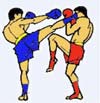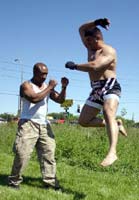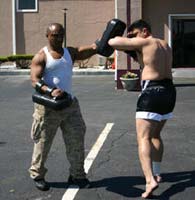| login |
|
| KICKBOXING AND MUAY THAI ALL INDIA KICKBOXING FEDERATION | |||||||||||||||||||
|
In the 1970's there were a lot of styles of martial arts that hit American soil. These Martial Arts were from different countries such as Japan, Korea, China etc. Competitions started and martial artists from these various styles started to compete, but they did not have a unified set of rules and each style thought that they were better than the other. Martial Artists in the USA the sat down and started what was then first known as full contact Karate, where competitors started to throw full powered blows (punches and kicks) to their opponents' face and body. Later on they realized the value of Western Boxing when they put on boxing gloves and fought these contests in a boxing ring. This was the beginning of Kickboxing. MUAY THAI
Techniques The basic offensive techniques in Muay Thai use fists, elbows, shins, feet, and knees to strike the opponent. To bind the opponent for both offensive and defensive purposes, small amounts of stand-up grappling are used: the clinch. The clinch is applied by holding the opponent either around the neck or around the body. In Western Boxing, the two fighters are separated when they clinch. Defensively, the concept of "wall of defense" is used, in which shoulders, arms and legs are used to hinder the attacker from successfully executing his techniques. Blocking is a critical element in Muay Thai and compounds the level of conditioning a successful practitioner must possess. Low and mid body roundhouse kicks are normally blocked with a raised shin. Mid to high body strikes are blocked with the forearm, knee/shin. Roundhouse kicks to the mid section are often blocked/accepted by a slight rotation of the torso so that the attacking shin strikes the back 1/4 of the rib cage. Mid section roundhouse kicks can also be caught/trapped, allowing for a sweep or counter attack to the remaining leg of the opponent. Muay Thai is often a fighting art of attrition, where opponents exchange blows with one another. This is certainly the case with traditional stylists in Thailand, but is a less popular form of fighting in the contemporary world fighting circuit. With the success of Muay Thai in mixed martial arts fighting, it has become the de facto martial art of choice for competitive stand-up fighters. As a result, it has evolved in order and incorporated much more powerful hand striking techniques used in western style boxing, and the Thai style of exchanging blow for blow is no longer favorable. Note: when Muay Thai fighters compete against fighters of other styles (and if the rules permit it), they almost invariably emphasize elbow (sok) and knee (kao) techniques to gain a distinct advantage in fighting. Muay Thai has demonstrated its effectiveness against other martial arts in a ring setting, many times, in Thailand and internationally. Due to the rigorous fighting and training regimen (some Thai boxers fight almost every other week) professional Muay Thai fighters have relatively short careers in the ring. Most professional Thai boxers come from the lower economic backgrounds and the fight money (after the other parties get their cut) is sought as means of support for the fighters and their families. Very few higher economic strata Thais join the professional Muay Thai ranks; they usually practice the sport as amateur Muay Thai boxers. ALL INDIA KICKBOXING FEDERATION
The All India Kickboxing Federation (AIKF) has been promoting Kickboxing and Muay Thai in India since 1986. It has held 16 National Kickboxing Championships and sanctioned numerous state and local championships all over India . Special Championships like the "Battle of Bombay", "Mahendra Brahmo Kickboxing Championships" and "North East Prize money Kickboxing Championships" have also been held on a professional level under sanction from the AIKF. At the AIKF we also have a complete Muay Thai- Kickboxing program which starts from Level - 1 (white band) to Level - 6 (Black band) and on to Level - 7 which is the Instructor (Kru) level ranking. Interested persons who wish to attain this ranking and begin our program in their schools/clubs/classes may contact us. The AIKF also gives sanctions for championships of all levels all over India. For our Muay Thai- Kickboxing program and/or championship sanctions contact |
||||||||||||||||||
| © 2009 Copyrights reserved with TaekwondoIndia.com | Designed by Interlink Consultants |


 KICKBOXING
KICKBOXING
